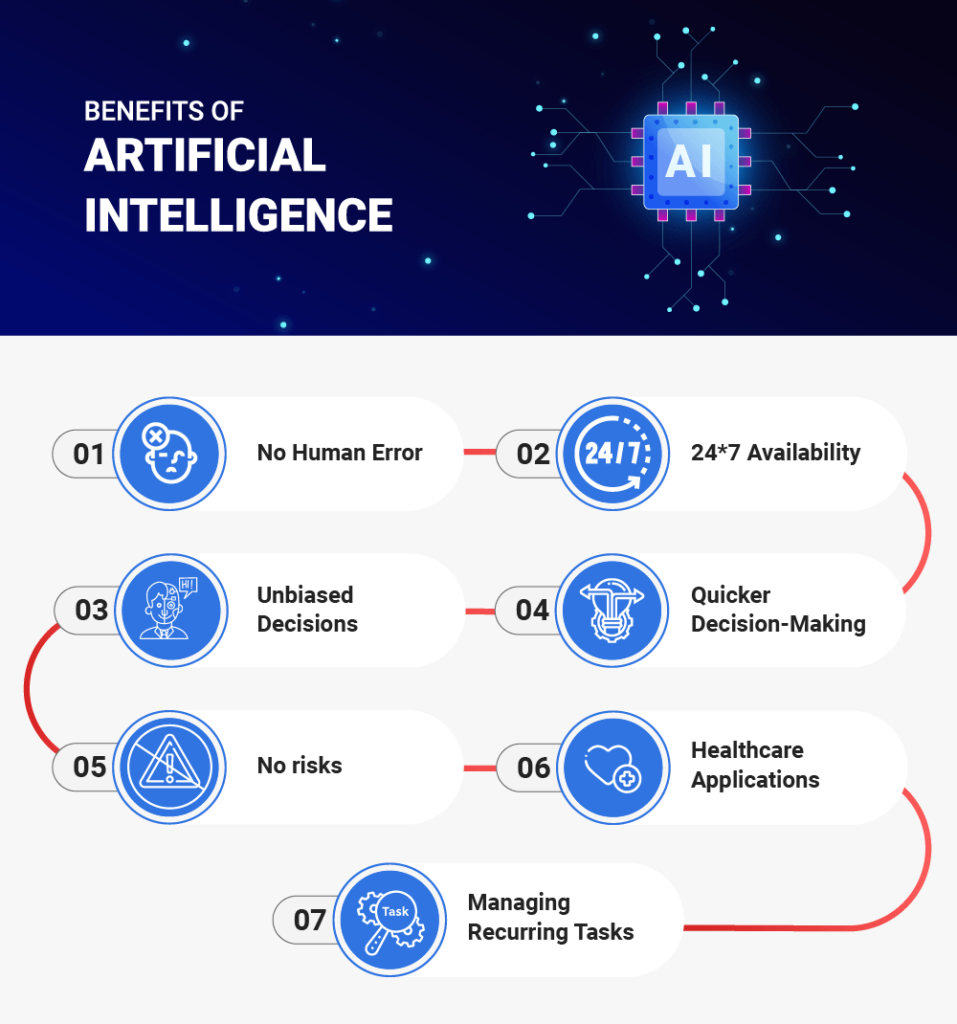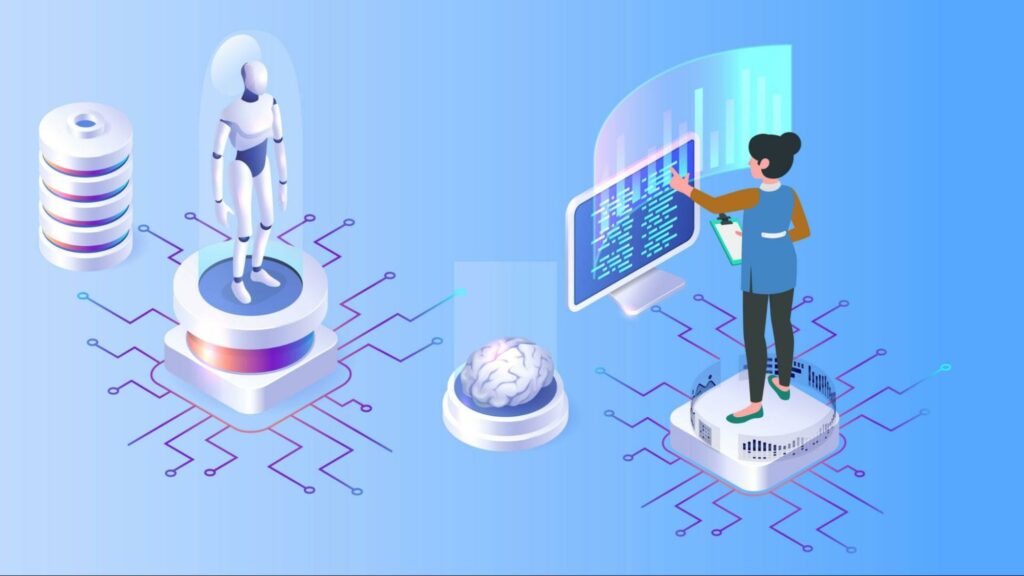The Power of Artificial Intelligence(AI) and Machine Learning(ML): The Next Technological Revolution

Introduction:
In today’s fast-paced digital world, Artificial Intelligence (AI) and Machine Learning (ML) have emerged as game-changing technologies. They have revolutionized various industries, from healthcare to finance, by enabling machines to learn from data and make intelligent decisions. In this blog, we will delve into the fascinating realm of AI and ML, exploring what they are, their benefits, and the common challenges they face.
What is AI AND ML :

Artificial Intelligence (AI) is the field of computer science dedicated to creating intelligent machines that can perform tasks requiring human-like intelligence. It encompasses various techniques, such as machine learning, natural language processing, and computer vision, to enable machines to understand, reason, and learn from data.
Machine Learning (ML) is a subset of AI that focuses on developing algorithms and models that allow machines to learn from data and make predictions or decisions. Through the analysis of large datasets, ML algorithms can recognize patterns, extract insights, and improve their performance over time without being explicitly programmed.
AI and ML are revolutionizing industries by automating processes, enabling data-driven decision-making, and creating innovative solutions to complex problems.
Benefits of AI and ML:

1. Automation and Efficiency: AI and ML technologies automate repetitive and mundane tasks, allowing humans to focus on more complex and creative endeavors. They can process vast amounts of data quickly and accurately, leading to increased productivity and efficiency in various domains.
2. Enhanced Decision Making: AI and ML algorithms can analyze large datasets, extract meaningful insights, and provide valuable recommendations. They assist decision-makers in making more informed choices, optimizing processes, and reducing errors.
3. Personalized Experiences: AI and ML enable businesses to personalize customer experiences by analyzing individual preferences, behavior patterns, and feedback. This leads to tailored recommendations, targeted marketing campaigns, and improved customer satisfaction.
4. Predictive Analytics: With the power of AI and ML, organizations can leverage predictive analytics to forecast trends, identify potential risks, and make proactive decisions. This helps in optimizing operations, minimizing downtime, and improving resource allocation.
5. Advancements in Healthcare: AI and ML have tremendous potential in healthcare, aiding in diagnosis, drug discovery, and personalized treatment plans. They can analyze medical records, genetic data, and clinical research to identify patterns, improve diagnostics, and develop innovative therapies.

Challenges in AI and ML:

1. Data Quality and Availability: AI algorithms require large quantities of high-quality data to train and make accurate predictions. However, businesses may encounter challenges in obtaining relevant and diverse datasets. Data quality issues, such as incomplete or inconsistent data, can hinder the effectiveness of AI models. Ensuring data accuracy, reliability, and accessibility is crucial for successful AI implementation.
2. Ethical Concerns: As AI and ML become more powerful, ethical dilemmas arise, such as privacy infringement, bias in algorithms, and the potential for automation-induced job displacement. Striking the right balance between technological advancements and ethical considerations is crucial.
3. Interpretability and Transparency:

Many AI algorithms, such as deep learning models, operate as black boxes, making it difficult to understand how they arrive at their decisions. In business contexts, interpretability and explainability are crucial for building trust and meeting regulatory requirements. Developing AI models that are transparent and provide interpretable outputs remains a challenge.
4. Continuous Learning and Adaptation: AI models need to continuously learn and adapt to evolving data and changing business dynamics. Businesses face challenges in designing AI systems that can adapt to new scenarios, incorporate new data, and handle concept drift. Developing algorithms and frameworks that enable continuous learning and efficient adaptation is crucial for long-term AI success.

5. Security and Vulnerabilities:

AI applications often handle sensitive data, making security and privacy major concerns. Protecting data from unauthorized access, ensuring data privacy compliance, and guarding against potential AI vulnerabilities and adversarial attacks require robust security measures. Implementing secure AI systems and maintaining data integrity throughout the AI lifecycle are ongoing challenges.
With the increasing adoption of AI and ML, the risk of cybersecurity threats and vulnerabilities also grows. Adversarial attacks, data breaches, and malicious use of AI technology require robust security measures and constant vigilance.
6. Skill Gap and Talent Acquisition:

Acquiring the right talent with expertise in AI and machine learning can be a significant challenge for businesses. The demand for AI professionals often exceeds the supply, leading to a skill gap. Recruiting and training employees with AI skills or collaborating with external AI experts become essential strategies to overcome this challenge.
7. Algorithm Selection and Optimization:
Choosing the right algorithms for specific business problems is critical. With a vast array of AI algorithms available, businesses may struggle to determine the most suitable ones for their needs. Additionally, optimizing and fine-tuning these algorithms to achieve the desired performance and accuracy can be time-consuming and complex.

8. Integration with Existing Systems:
Integrating AI solutions into existing business processes and systems can be challenging. Legacy systems may not be compatible with AI technologies, requiring significant effort to bridge the gap. Ensuring seamless integration, data flow, and interoperability with existing software and infrastructure is essential for successful AI implementation.
Solutions to Technological Challenges in AI Adoption for Businesses

1. Data Quality and Availability:
a. Develop robust data governance practices to ensure data quality, consistency, and accessibility.
b. Invest in data cleansing and preprocessing techniques to address data quality issues.
c. Collaborate with external data providers or consider data augmentation techniques to enrich and diversify datasets.
2. Scalability and Infrastructure:
a. Leverage cloud computing services that offer scalable and on-demand resources for AI applications.
b. Implement containerization and orchestration technologies like Docker and Kubernetes to efficiently manage AI infrastructure.
c. Explore edge computing to distribute AI processing closer to the data source, reducing latency and enhancing scalability.

3. Algorithm Selection and Optimization:
a. Collaborate with data scientists and AI experts to identify the most appropriate algorithms for specific business problems.
b. Conduct thorough experimentation and benchmarking to optimize algorithm parameters and fine-tune model performance.
c. Consider leveraging pre-trained models or transfer learning techniques to accelerate model development.
4. Interpretability and Explainability:
a. Implement algorithms that provide interpretability, such as decision trees or rule-based models, for use in critical applications.
b. Utilize techniques like feature importance analysis or model-agnostic approaches (e.g., LIME, SHAP) to explain AI model decisions.
c. Invest in research and development to enhance the interpretability of complex AI models like deep neural networks.
5. Integration with Existing Systems:
a. Adopt modular and API-driven architectures to facilitate seamless integration of AI components into existing systems.
b. Utilize middleware or data integration platforms to ensure smooth data flow between AI systems and legacy applications.
c. Consider leveraging microservices and service-oriented architectures (SOA) to enable flexibility and interoperability.
6. Security and Privacy:
a. Implement robust data encryption and access control mechanisms to safeguard sensitive AI data.
b. Regularly conduct security audits and vulnerability assessments to identify and mitigate potential risks.
c. Stay updated with industry standards and regulations to ensure compliance with data privacy laws (e.g., GDPR, CCPA).

7. Continuous Learning and Adaptation:

a. Implement online learning techniques that allow AI models to adapt to evolving data in real-time.
b. Set up mechanisms to monitor and detect concept drift, triggering model retraining or adaptation as necessary.
c. Foster a culture of continuous learning and encourage collaboration between data scientists and domain experts.
8. Skill Gap and Talent Acquisition:

a. Invest in training programs and provide opportunities for upskilling existing employees in AI and ML.
b. Foster partnerships with academic institutions to tap into emerging talent pools.
c. Collaborate with external AI consulting firms or hire experienced AI professionals on a contractual basis.
By addressing these solutions, companies can overcome the technical challenges associated with AI adoption. It is important for organizations to create a strategic roadmap, allocate resources effectively, and foster a culture of innovation to successfully implement AI and reap its benefits.

Explore how AI can transform your business, discover the latest advancements, and learn about our tailored solutions to meet your specific needs. Visit our website(www.eitacies.com) today to unlock the potential of AI and stay ahead in the rapidly evolving digital landscape.
www.eitacies.com/services/engineer/machine-learning-artificial-intelligence

